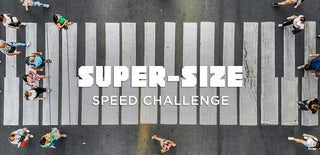Introduction: Super Sized Playing Card
This Jumbo Super-Sized Playing Card made from scratch was an idea that I have had for many years, finally being able to create it was practically a dream come true. The idea initially came to me when I was playing with a standard deck of Jumbo Bicycle Playing Cards, and although it said "Jumbo" in the name, it wasn't much larger than a regular deck of cards. Since then, I have always wanted to make a playing card that I could proudly pronounce as "Jumbo."
Step 1: Gather Your Supplies:
- Multiple Pieces of Printer Paper (Or Plain White Paper)
- Clear Tape
- Sharpie / Marker (Various Thickness)
- Colored Pencil / Crayon
- Pencil
- Eraser
- Scissors / Blade
- Cardboard
- 1 playing card
- Ruler
- Glue Stick
Step 2: Making a the Base:
For starters choose the playing card that you want to super-size! This can be completely your choice as it can be any card ranging from Standard playing cards, Uno, Pokémon, or even a debit or credit card. Whatever you find as an interest, go for it, just remember to stay dedicated to what you are doing. Once you have found a card, (which I personally chose the Ace of Spades) measure the length and width to create a proportional size to replicate onto the cardboard. Although this is an optional step, this will serve very beneficial in the long run, especially if you are replicating a picture that has an intricate design all over the card. Coincidentally for us, our cardboard was already the perfect size!
Step 3: Mapping Out the Card:
Once you have made a properly sized cardboard base, you will then want to lay down pieces of paper onto the cardboard so they cover the entire face of the board. (You may need to cut some pieces of paper to fit it exactly like we had to.)
Step 4: Taping the Pieces of Paper Together:
Once you are confident that you have laid out the pieces evenly, proceed to tape the pieces of paper together. Make sure no piece of paper overlaps another as it will clearly show the overlap even from far away. Thus, you will want to make sure that the papers are as close to each other as possible without any overlap, creating a seamless effect. The end product should look like one giant piece of paper. (Do NOT glue down the paper to the cardboard just yet.)
Step 5: Making the Initial Sketch:
Without gluing the paper onto the board, take your pencil and sketch your chosen design onto the paper. This may take a while, and to avoid " heavy-duty mistakes" make sure to gently apply pressure to the paper without pressing down too hard as it may leave behind a mark when we erase the pencil later. As an extra step of precaution, you may want to practice your design on another sheet of paper, before drawing the real deal.
Step 6: The Inking Process:
With the sketch complete, take your marker or inking tool and carefully outline and color the piece over the pencil marks. Make sure to execute this step scrupulously as it may be impossible to undo mistakes with ink. (However, it becomes much easier with the baseline pencil sketch, where one was free to mess up.)
Step 7: Erasing:
After the final ink and coloring have been completed, take your eraser and erase every place where you had once applied the pencil. This will get rid of any visible graphite marks, thus creating a clean and crisp look. Don't be afraid to erase directly over the ink, no, the ink will not smear all over the page nor will it become lighter. (If you are adding color to the piece with an erasable substance such as colored pencil or crayon, make sure to use the erasing technique right after you have inked the piece or BEFORE you add the color.)
Step 8: "Cutting Corners":
With the main design creating aspect of the project completed, gently mark rounded lines with a pencil on each of the four corners of the card. Next, take a blade or pair of scissors (whichever feels more natural to you) and cut along the marks you made on the corners. On most cards, the edges are always rounded off, thus rounding the corners will give it a more realistic look.
Step 9: Finally Pasted:
As the project comes to an end, glue the final paper onto the cardboard to give it a sturdy base. (Personally, I find a glue stick to be the best for this step as liquid glue would leave a visible mark through the paper.) This is the last step of the project and now you can enjoy an enlarged super-sized portrait of a playing card!

Participated in the
Super-Size Speed Challenge













